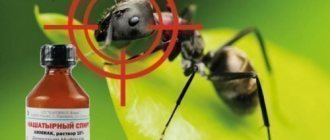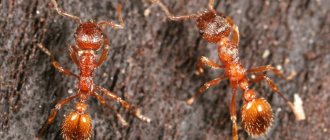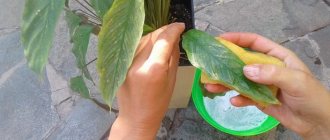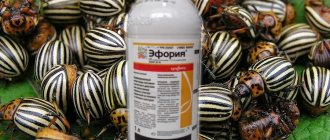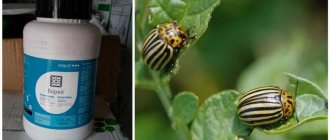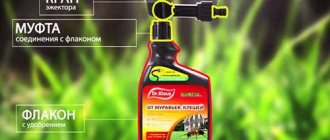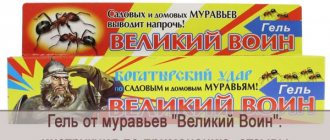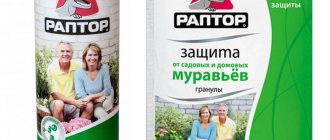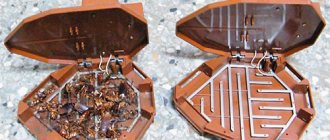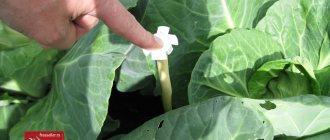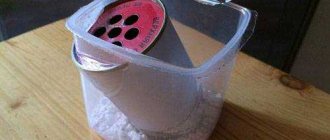Sodium bicarbonate, or simply baking soda, is not only an assistant in cooking, but also an indispensable tool in the fight against garden pests. Low cost - about 35 rubles per 500 grams and the ability to purchase in any store make this product accessible to every gardener.
Proponents of natural pest control also love baking soda. This product is absolutely safe for both people and plants. Baking soda can be used to treat trees and bushes even at the time of fruiting.
In stores you can find various mixtures with the addition of soda and its modifications. This article is devoted to the simplest and cheapest - GOST 2156-76. Usually sold in red and yellow cardboard packages of 500 g.
It’s worth saying right away that using soda in pest control, we kill two birds with one stone. First, we destroy insects. Secondly, we protect the plant from diseases.
Benefits of baking soda
- Low cost;
- Available at any grocery store;
- Naturalness and environmental friendliness;
- Does not harm beneficial insects such as bees;
- Safe for people, animals and plants;
- No special conditions are required for storage;
- Long shelf life.
This list can be continued endlessly. However, all these benefits can be negated if you do not know how to use baking soda correctly. Below, we will talk about just this.
How to get rid of aphids on currants
There is a big difference between baking soda and soda ash, although the two products are similar in appearance. The first is an odorless white powder with a neutral, slightly bitter taste, safe. Soda ash is classified in the third hazard class: the product can cause burns of mucous membranes and irritation of the skin. The product requires the use of protective equipment - gloves, a respirator. Both types of soda are suitable for gardeners; they have found use in treating plants against fungi and pests, including aphids.
Soda for aphids on currants and other fruit bushes is applied by spraying - moving from bottom to top so that the lower part of the leaves is better treated. It is optimal to carry out the procedure early in the morning or late in the evening and in dry weather. When treating currant leaves against gall aphids, it is necessary to turn them over, and when treating currant leaves against gall aphids, unroll them so that the active substance falls directly on the pest. It is recommended to use a hand sprayer rather than a standard sprayer.
Folk remedies for aphids on currants show high effectiveness, but if the bushes are severely damaged and contain a lot of swollen, twisted, reddened leaves, such greenery must be torn off and burned, it cannot be saved.
Soda against caterpillars
soda can be successfully used against caterpillars
Baking soda is an excellent remedy against caterpillars that devour cabbage and other plants in our beds. In order to get rid of pests, it is necessary to apply an even layer of soda to the heads of cabbage and leaves. In order for the powder to stick, this must be done at a time when the plant is wet. Pay attention to the wind. It can carry away small grains of sand, which will negate all the work.
Caterpillars and slugs will avoid a plant covered with soda. This method can be used at any stage of fetal formation and maturation.
The secret of action
When the soda solution gets on the body of small pests, it causes irritation and minor damage. The insects are trying to escape, but they are prevented from doing so by soap, which is necessarily included in the solution. The soap detergent holds the soda on the surface of the plant leaves and increases its shelf life.
On a note!
Soda ash for aphids is used along with baking soda. There is no particular difference in the effect. Preference is given to this product because it saturates the plant with calcium, increases resistance to disease, and promotes the rapid restoration of damaged areas of leaves.
Soda against wireworms
Baking soda can protect potatoes from wireworms
If you have ever encountered wireworms, then you know very well that this pest can destroy an entire potato crop in a matter of weeks. If it has already started, it is quite difficult to get rid of it, therefore, you need to be proactive. Even at the time of planting potatoes, sprinkle a small amount of baking soda into the furrow. Dosage - 1/2 medium teaspoon per well. This will discourage any desire of the wireworm to eat your potatoes.
Moreover, practice shows that soda is capable of removing even a massive infestation of this pest. It’s worth saying right away that it often takes not one, but two or even three years to completely get rid of this pest.
The harm of soda in the garden
There may be an opinion that soda is unusually good for the garden, but many homeowners warn against using this powder. Their arguments are very reasonable.
Since soda is sodium, an element that is conditionally necessary for plants (to a greater extent - spinach and tomatoes, to a lesser extent - legumes), its excess can lead to disastrous consequences, including the death of green pets.
Another disastrous result of using soda is soil salinization, which is called soda or carbonate salinization. As a result of such salinization, the soil ceases to be fertile (the structure is damaged, useful substances are washed out), therefore the yield is significantly reduced (from 25% in slightly saline soils to 75% in highly saline soils).
As you can see, the consequences of uncontrolled use of soda can be catastrophic. *** So is it worth using baking soda in the garden? Perhaps every summer resident will find the answer to this question himself through research. However, we can say for sure that you should not thoughtlessly scatter the powder all over the area.
Before using baking soda in the garden, remember the main safety rule. Do not cover all your land or plants with it at once. First, try the product on a small piece of land or a separate green pet. Watch what reaction follows. If the result satisfies you, continue. As with other gardening experiments, the key with soda is moderation and common sense.
Tell us in the comments if you used baking soda in the garden, and what was the result?
Soda against aphids
Baking soda is successfully used against aphids
. Aphids are insects that instantly infect plants and suck all the juices out of them. Despite their small size, aphids can even destroy trees. Using soap and manual processing often does not bring the desired effect. Therefore, soda, a proven and effective remedy, comes into the fight. Treatment with soda solution kills aphids without causing any harm to the plant.
Prepare a soda solution as follows. Add 2 heaped tablespoons of baking soda to a 5-liter jar of warm water. Mix thoroughly. Add natural soap to the resulting solution. This is done so that the soda sticks to the leaves and branches.
The plant is treated with a spray bottle or any small sprayer. If the tree bears fruit at the time of processing, the fruits to be eaten should be rinsed with water. Otherwise you will taste the soap.
If aphids have infested small areas of the plant, they can be removed manually before treatment. This will make processing more efficient.
Soda ash and baking soda. Features of use in the country
There are several types of soda: soda ash or laundry soda (sodium carbonate, a colorless crystalline substance), caustic (sodium hydroxide, white flaky granules), crystalline (crystalline hydrates of soda ash, colorless crystals, grains or powders). Regular baking soda, a finely crystalline white powder, is a product found in every kitchen. This is, from a chemical point of view, sodium bicarbonate.
Each type of soda is used in different situations: from cooking to the automotive industry. As for the garden and vegetable garden, two types of soda are used here - soda ash and baking soda.
Baking soda is sold in any grocery store, but calcined soda is more difficult to buy. Most often, this product can be found in hardware stores, since its main purpose in everyday life is to clean the kitchen and bathroom.
When working with soda in the garden, remember a few important rules:
- To protect your hands when working with soda ash, always wear gloves;
- When making a soda solution, do not use water that is too hot, more than 60°C. Soda dissolves poorly in boiling water and loses its beneficial properties;
- Since the powder can spoil the metal, it is advisable not to dilute it in metal containers, but use plastic ones.
Soda against ants
Baking soda is effective in controlling garden ants
Garden ants are small pests that, in addition to everything else, spread aphids. These insects simply hate soda. They are not able to live in the places where she is present.
To effectively control ants with baking soda, you need to think strategically. First of all, you need to find all anthills, nests and passages on your site. If we are talking about a greenhouse, these are usually corners or cracks in the foundation. After the habitats have been found, you need to dig up all the houses in one day and cover them generously with soda. In order for the powder to penetrate deep into the passages, you need to use water. Abundant watering will spread the soda far into the depths of the anthill. After such an attack, the ants will not have the strength to settle in their original places again.
Efficiency
Baking soda against aphids is one of the most effective remedies. It is used in the garden, in the garden on vegetables, fruit trees, flowers, and berries.
Using soda solution
The result depends on the degree of damage to the land plot and weather conditions. The result is noticeable 3 days after thorough spraying. Gardeners and gardeners talk about the effectiveness of soda solution.
Garlic-soda solution for treating currants against aphids
To increase the effectiveness of soda treatment, other active ingredients, including garlic, are added to the main product. The latter is a natural antibiotic with a sharp, persistent aroma that forces aphids to leave their favorite plants. Ingredients needed for preparation:
- soda ash - 2 tbsp. l. (or food - 10 tbsp.);
- garlic – 150 g;
- laundry soap – 100 g;
- water – 10 l.
Chopped garlic (the optimal consistency is gruel) must be added to a bucket of water and left to steep for 6 hours. Then add soda and grated soap to the solution. A thoroughly mixed, strained solution is sprayed on the bush from all sides when signs of aphids appear. After the procedure, pests leave the currants within 1-2 days.
What is it for?
Sodium bicarbonate, commonly referred to as baking soda or baking soda, is a snow-white powder available on hand in any home. There are quite a few ways to use the product to improve the development of currants:
- the sodium contained in the substance accelerates the absorption of nutrients from the soil;
- the use of soda reduces the acidity of the soil;
- an alkaline solution serves as a means of preventing and protecting currants from powdery mildew;
- baking soda is one of the best folk remedies for killing aphids and other pests;
- treatments eliminate sodium deficiency in the soil - the lack of an element prevents currants from absorbing moisture and reduces frost resistance;
- soda solution is used to destroy weeds.
In case of severe damage to currants by diseases or pests, soda ash (sodium carbonate) is used. More concentrated alkali requires caution when diluting and using.
